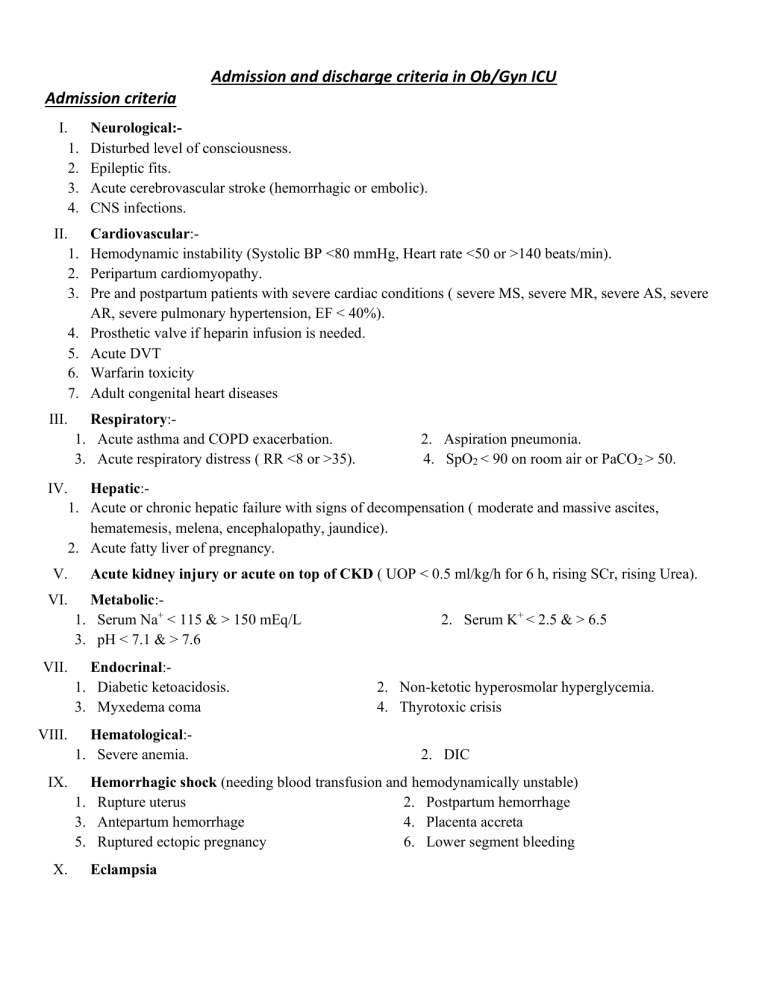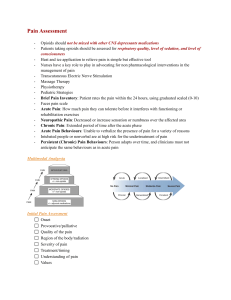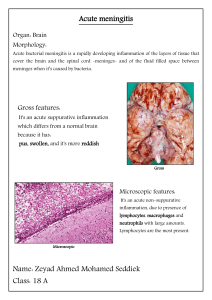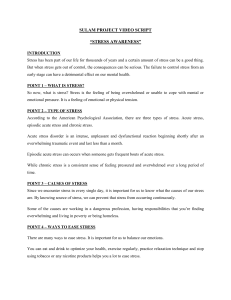
Admission and discharge criteria in Ob/Gyn ICU Admission criteria I. 1. 2. 3. 4. II. 1. 2. 3. 4. 5. 6. 7. III. Neurological:Disturbed level of consciousness. Epileptic fits. Acute cerebrovascular stroke (hemorrhagic or embolic). CNS infections. Cardiovascular:Hemodynamic instability (Systolic BP <80 mmHg, Heart rate <50 or >140 beats/min). Peripartum cardiomyopathy. Pre and postpartum patients with severe cardiac conditions ( severe MS, severe MR, severe AS, severe AR, severe pulmonary hypertension, EF < 40%). Prosthetic valve if heparin infusion is needed. Acute DVT Warfarin toxicity Adult congenital heart diseases IV. Respiratory:1. Acute asthma and COPD exacerbation. 3. Acute respiratory distress ( RR <8 or >35). 2. Aspiration pneumonia. 4. SpO2 < 90 on room air or PaCO2 > 50. V. Hepatic:1. Acute or chronic hepatic failure with signs of decompensation ( moderate and massive ascites, hematemesis, melena, encephalopathy, jaundice). 2. Acute fatty liver of pregnancy. VI. VII. VIII. IX. X. Acute kidney injury or acute on top of CKD ( UOP < 0.5 ml/kg/h for 6 h, rising SCr, rising Urea). Metabolic:1. Serum Na+ < 115 & > 150 mEq/L 3. pH < 7.1 & > 7.6 Endocrinal:1. Diabetic ketoacidosis. 3. Myxedema coma Hematological:1. Severe anemia. 2. Serum K+ < 2.5 & > 6.5 2. Non-ketotic hyperosmolar hyperglycemia. 4. Thyrotoxic crisis 2. DIC Hemorrhagic shock (needing blood transfusion and hemodynamically unstable) 1. Rupture uterus 2. Postpartum hemorrhage 3. Antepartum hemorrhage 4. Placenta accreta 5. Ruptured ectopic pregnancy 6. Lower segment bleeding Eclampsia XI. Preeclampsia complicated by:1. HELLP 3. Pulmonary edema XII. 2. Cerebral venous thrombosis 4. Acute kidney injury • • • • Sepsis complicated by multi organ failure & caused by any septic focus e.g. Puerperal sepsis IUFD Postoperative wound infection Infective endocarditis • • • • Ovarian hyperstimulation syndrome complicated by:DVT Respiratory distress Electrolyte disturbance Generalized edema XIII. XIV. • • Hyperemesis gravidarum complicated by:Electrolyte and acid base imbalance Severe dehydration. • Venous thrombosis Discharge criteria:1. Patient not on any support or intervention (or unlikely to need them in the next 24 hours) that cannot be provided in the ward. This includes equipment and nurse staffing issues. 2. Low likelihood of deterioration in the next 24 hours. For long-stay patients and those with low systemic reserve, the duration should be extended to 48 hours or more. 3. Supplemental inspired oxygen concentration <50%. 4. Hemodynamically stable. 5. Cardiac dysrhythmias are controlled. 6. The admission etiological factor is under control or not significant any more. Reference:1. Principles of Critical Care in Obstetrics. (2016) 2. Department of Health Working Group. Guidelines on Admission to and Discharge from Intensive Care and High Dependency Care Units. London:Department of Health. (1996)





